Plants produce essential oils to protect themselves. You can use them too.

Introduction
Plants produce chemical compounds to protect themselves and stay healthy. Many plants produce volatile (quickly evaporating) oils. We call them essential oils because they contain the essence of the plant and are essential to the health of the plant. Without these oils, the plant would quickly succumb to diseases. It is very remarkable how versatile these little compounds are. They can work as deterrents to bugs, many different bacteria, and even viruses! While essential oils are essential to keep plants healthy, there are many ways humans can benefit from them as well. We'll talk about some of the most well-researched oils that have broad antiviral properties in this blog post.
Note: I always cite my scientific sources and those are found in the drop-down tab at the bottom titled "References". References to those sources are numbered in brackets [#] at the end of the sentences.
Most people don’t know that there has been a lot of scientific research into the efficacy of essential oils for their pharmacological effects, such as antibacterial, anti-fungal, antiviral, anti-inflammatory, immune-supporting, antioxidant, and wound-healing effects [1]. In general, it has been found that essential oils work to kill microorganisms through a process of membrane disruption. The microbial cells are like bubbles and essential oils pop those bubbles [2, 3].
Most essential oils are mixtures of different chemical compounds, usually with one dominant compound. This is the compound that provides the plant with the most beneficial qualities, such as anti-inflammatory, antiviral, antibacterial, or anti-fungal properties.
*Disclaimer* This information is not intended to be advice of substitutes for vaccination and does not negate the need for proper vaccination for the prevention of viral infection. It is also not intended to diagnose, treat, cure, or prevent any disease.
Cinnamon bark
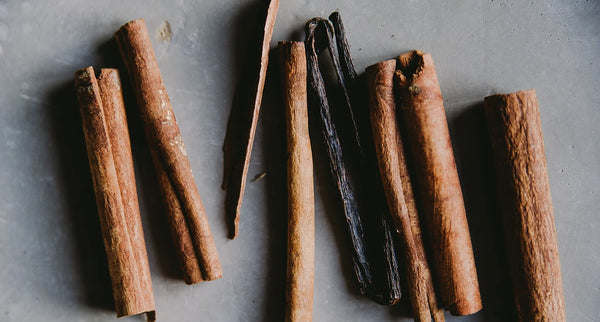
Cinnamon essential oils come from the bark of two main species of tree: Cinnamonum zeylonica and cassia. Both are high in a chemical compound called cinnamaldehyde which makes up 60-80% of the oil and has been well-researched for both its antibacterial and antiviral properties.
In-vitro (in-lab) studies have demonstrated cinnamon oil’s ability to kill influenza (flu) virus better than other essential oils tested [4]. Scientists at the University of British Columbia in Vancouver, BC tested nine essential oils to find which one had the best antiviral properties. The essential oils of lavender, geranium, cinnamon, sage, eucalyptus, lemongrass, red thyme, bergamot, and cypress were tested in-vitro against the H1N1 influenza (swine flu) virus. They found that cinnamon oil had the strongest antiviral effects of the nine. Cinnamon oil was able to inactivate the virus completely at a 0.0003% concentration!
Computer-generated models have found that cinnamaldehyde has the potential to bind to the SARS-CoV-2 spike protein and potentially disrupt the virus’ ability to get into cells [5]. Computer models don’t always simulate real life very well though. More research needs to be done to confirm this effect in in-vitro and human studies.
Clove bud
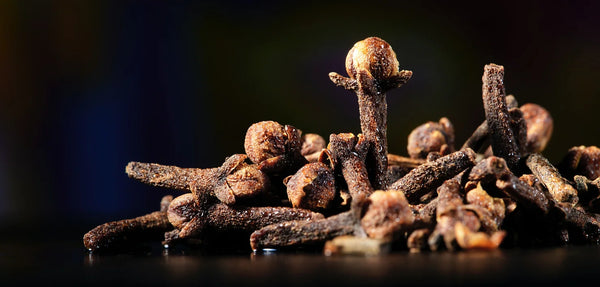
Clove is the budding flower of the Syzygium aromaticum tree. The clove bud is often used in seasonal drinks and foods and has a very strong flavor and aroma. Clove buds are commonly chewed in Asia to treat sore throat and to stop coughs [6] and the oil has strong anti-inflammatory properties [7]. The main active compound in clove essential oil is called eugenol, which makes up 70-80% of the oil [8].
Clove essential oil was found to have anti-influenza properties [9]. The researchers tested 86 different Chinese herbs and found that eugenol from clove essential oil was the most effective at inhibiting the influenza virus as well as a process called autophagy, which is cell self-destruction. This prevents the virus from escaping the cell and spreading to other cells.
Oregano and thyme leaves
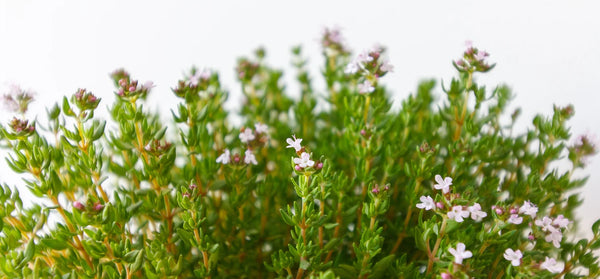
Oregano and thyme are small shrubs from the Origanum family. The leaves put out a strong aroma that is unmistakable. They have a spicy and pungent flavor that makes them favorites in Italian seasoning. The essential oil composition of oregano and thyme essential oils are very similar. Both oregano and thyme essential oils are rich in carvacrol and thymol, which are almost structurally identical compounds that makeup about 40-70% of the oils.
Thymol and carvacrol were tested against the herpes simplex virus (HSV) and found to inhibit viral reproduction by over 80% when incubated in-vitro with the virus and human cells in concentrations non-toxic to humans [11]. The concentration required to inhibit 50% of the virus particles was 0.002% for thymol and 0.037% for carvacrol.
Another study showed carvacrol and thymol could inhibit the HIV-1 virus in-vitro by inhibiting the entry of the virus into the cell [12]. The oils were able to deplete the virus envelope of cholesterol which made it unable to merge with the human cells.
And most recently (perhaps most relevantly too), carvacrol was found, through computer-generated molecular docking programs, to bind to the main protein-digesting enzyme (protease) of SARS-CoV-2 and thus has the potential to inhibit the virus [13, 14].
Eucalyptus leaf

Eucalyptus oil comes from the leaf of the Eucalyptus globulus tree that grows native to Australia. If you have ever seen videos of koalas snacking on leaves, they are most likely eucalyptus tree leaves, which make up their primary diet. Eucalyptus oil’s active compound, eucalyptol (also called 1,8-cineole), varies widely in its concentration, making up between 30 and 80% of the oil. Both eucalyptol and eucalyptus essential oil have been extensively tested for their antiviral properties against several different viruses.
In human trials, eucalyptol was found to reduce inflammation, reduce bronchial spasms, clear out mucus, and improve lung function of patients suffering from COPD and asthma [21, 22]. The use of eucalyptus essential oil can potentially improve the outcomes of COPD and asthma patients suffering from any type of viral or bacterial lung infection and reduce sick time.
Eucalyptus oil was tested against HSV and found to inhibit the virus by over 96%[15]. Another study found that Eucalyptus oil reduced HSV-1 by 57.9% and HSV-2 by 75.4% [16].
Several computer-generated models have shown strong simulated binding of eucalyptus oils and a SARS-CoV-2 enzyme that regulates protein production, which suggests that eucalyptus oils may have an inhibitory function against Covid-19 [14, 17, 18]. Further in-vitro and in-vivo (in-person) testing is needed to confirm this effect though.
An in-vitro study of the antiviral properties of eucalyptus aerosol found that a concentration of 0.0125% in the air for 15 seconds inhibited influenza by 95%[19]. Another study found that eucalyptus oil was able to completely inhibit influenza at a concentration of 0.005% when incubated with cells in a petri dish [4]. A study done in mice found that the main component of eucalyptus oil (eucalyptol) effectively improved the outcome of influenza infection by reducing inflammation and preventing pneumonia [20].
Delivery Method
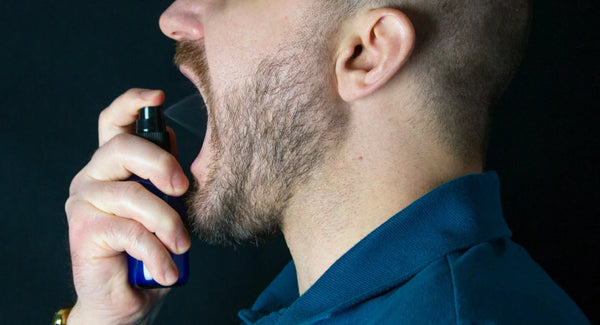
One of the most important pharmacological principles to consider when treating disease is the delivery method. You want to be able to deliver the right amount of the active compounds to the diseased area of the body in the right form.
In all the studies we reviewed, the essential oils were delivered to the cells and the viruses at specific concentrations. This is very important because at lower concentrations the essential oils had less effectiveness against the viruses. The dose makes the poison (in this case, poison to the virus). Diffusing oils might be helpful, but diffusing oils will dilute them in the air and much of what is diffused doesn’t make it into your lungs because it is lost in the air and deposited on surfaces in your house.
Bronchia Guard
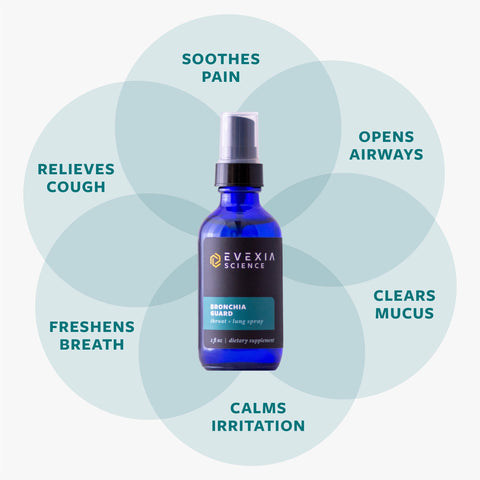
Bronchia Guard is a throat and lung spray that is made for cough and sore throat and contains 100% natural peppermint, eucalyptus, oregano, cinnamon, and clove essential oils that are diluted to the proper concentration, delivered directly where you need them in a mist form. It comes in a convenient 2 oz spray bottle for you to carry with you in your purse or pocket when you need it—whether you’re a commuter, frequent flyer, teacher, preacher, healthcare professional, or just someone who wants to be prepared for the winter season. Get your bottle today! (And while you’re at it, pick up an extra for a friend—you’ll get free shipping on all orders!)
Check out the reviews here to see what our customers are saying! (Spoiler: it really works to stop a cough.)
Learn more about Bronchia Guard by clicking here
References
- Reichling, J. Antiviral and Virucidal Properties of Essential Oils and Isolated Compounds - A Scientific Approach. Planta Med., 2021. https://doi.org/10.1055/a-1382-2898.
- Wińska, K.; Mączka, W.; Łyczko, J.; Grabarczyk, M.; Czubaszek, A.; Szumny, A. Essential Oils as Antimicrobial Agents—Myth or Real Alternative? Molecules, 2019, 24 (11), 2130. https://doi.org/10.3390/molecules24112130.
- Wink, M. Potential of DNA Intercalating Alkaloids and Other Plant Secondary Metabolites against SARS-CoV-2 Causing COVID-19. Diversity, 2020, 12 (5), 175. https://doi.org/10.3390/d12050175.
- Vimalanathan, S. Anti-Influenza Virus Activity of Essential Oils and Vapors. Am. J. Essent. Oils Nat. Prod., 2014, 2, 47–53.
- Kulkarni, S. A.; Nagarajan, S. K.; Ramesh, V.; Palaniyandi, V.; Selvam, S. P.; Madhavan, T. Computational Evaluation of Major Components from Plant Essential Oils as Potent Inhibitors of SARS-CoV-2 Spike Protein. J. Mol. Struct., 2020, 1221, 128823. https://doi.org/10.1016/j.molstruc.2020.128823.
- Pharmacognosy, J. O.; Bhowmik, D.; Kumar, K. P. S.; Yadav, A.; Srivastava, S.; Paswan, S.; Sankar, A. Recent Trends in Indian Traditional Herbs Syzygium Aromaticum and Its Health Benefits.
- Özbek, H. The Anti-Inflammatory Activity of Eugenia Caryophllata Essential Oil: An Animal Model of Anti-Inflammatory Activity. Eur. J. Gen. Med. ISSN 1304-3897 Vol 2 Num 4, 2005, 2. https://doi.org/10.29333/ejgm/82334.
- Mittal, M.; Gupta, N.; Parashar, P.; Mehra, V.; Khatri, M. PHYTOCHEMICAL EVALUATION AND PHARMACOLOGICAL ACTIVITY OF SYZYGIUM AROMATICUM: A COMPREHENSIVE REVIEW. Int. J. Pharm. Pharm. Sci., 2014, 67–72.
- Dai, J.-P.; Zhao, X.-F.; Zeng, J.; Wan, Q.-Y.; Yang, J.-C.; Li, W.-Z.; Chen, X.-X.; Wang, G.-F.; Li, K.-S. Drug Screening for Autophagy Inhibitors Based on the Dissociation of Beclin1-Bcl2 Complex Using BiFC Technique and Mechanism of Eugenol on Anti-Influenza A Virus Activity. PloS One, 2013, 8 (4), e61026. https://doi.org/10.1371/journal.pone.0061026.
- Tragoolpua, Y.; Jatisatienr, A. Anti-Herpes Simplex Virus Activities of Eugenia Caryophyllus (Spreng.) Bullock & S. G. Harrison and Essential Oil, Eugenol. Phytother. Res., 2007, 21 (12), 1153–1158. https://doi.org/10.1002/ptr.2226.
- Sharifi-Rad, J.; Salehi, B.; Schnitzler, P.; Ayatollahi, S. A.; Kobarfard, F.; Fathi, M.; Eisazadeh, M.; Sharifi-Rad, M. Susceptibility of Herpes Simplex Virus Type 1 to Monoterpenes Thymol, Carvacrol, p-Cymene and Essential Oils of Sinapis Arvensis L., Lallemantia Royleana Benth. and Pulicaria Vulgaris Gaertn. Cell. Mol. Biol. Noisy--Gd. Fr., 2017, 63 (8), 42–47. https://doi.org/10.14715/cmb/2017.63.8.10.
- Mediouni, S.; Jablonski, J. A.; Tsuda, S.; Barsamian, A.; Kessing, C.; Richard, A.; Biswas, A.; Toledo, F.; Andrade, V. M.; Even, Y.; et al. Oregano Oil and Its Principal Component, Carvacrol, Inhibit HIV-1 Fusion into Target Cells. J. Virol., 2020, 94 (15), e00147-20. https://doi.org/10.1128/JVI.00147-20.
- Kumar, A.; Choudhir, G.; Shukla, S. K.; Sharma, M.; Tyagi, P.; Bhushan, A.; Rathore, M. Identification of Phytochemical Inhibitors against Main Protease of COVID-19 Using Molecular Modeling Approaches. J. Biomol. Struct. Dyn., 2021, 39 (10), 3760–3770. https://doi.org/10.1080/07391102.2020.1772112.
- da Silva, J. K. R.; Figueiredo, P. L. B.; Byler, K. G.; Setzer, W. N. Essential Oils as Antiviral Agents, Potential of Essential Oils to Treat SARS-CoV-2 Infection: An In-Silico Investigation. Int. J. Mol. Sci., 2020, 21 (10), 3426. https://doi.org/10.3390/ijms21103426.
- Astani, A.; Reichling, J.; Schnitzler, P. Comparative Study on the Antiviral Activity of Selected Monoterpenes Derived from Essential Oils. Phytother. Res., 2010, 24 (5), 673–679. https://doi.org/10.1002/ptr.2955.
- Schnitzler, P.; Schön, K.; Reichling, J. Antiviral Activity of Australian Tea Tree Oil and Eucalyptus Oil against Herpes Simplex Virus in Cell Culture. Pharm., 2001, 56 (4), 343–347.
- Panikar, S.; Shoba, G.; Arun, M.; Sahayarayan, J. J.; Usha Raja Nanthini, A.; Chinnathambi, A.; Alharbi, S. A.; Nasif, O.; Kim, H.-J. Essential Oils as an Effective Alternative for the Treatment of COVID-19: Molecular Interaction Analysis of Protease (Mpro) with Pharmacokinetics and Toxicological Properties. J. Infect. Public Health, 2021, 14 (5), 601–610. https://doi.org/10.1016/j.jiph.2020.12.037.
- Fitriani, I.; Utami, W.; Zikri, A.; Santoso, P. In Silico Approach of Potential Phytochemical Inhibitor from Moringa Oleifera, Cocos Nucifera, Allium Cepa, Psidium Guajava, and Eucalyptus Globulus for the Treatment of COVID-19 by Molecular Docking; 2020. https://doi.org/10.21203/rs.3.rs-42747/v1.
- Usachev, E. V.; Pyankov, O. V.; Usacheva, O. V.; Agranovski, I. E. Antiviral Activity of Tea Tree and Eucalyptus Oil Aerosol and Vapour. J. Aerosol Sci., 2013, 59, 22–30. https://doi.org/10.1016/j.jaerosci.2013.01.004.
- Li, Y.; Lai, Y.; Wang, Y.; Liu, N.; Zhang, F.; Xu, P. 1, 8-Cineol Protect Against Influenza-Virus-Induced Pneumonia in Mice. Inflammation, 2016, 39 (4), 1582–1593. https://doi.org/10.1007/s10753-016-0394-3.
- Juergens, L. J.; Worth, H.; Juergens, U. R. New Perspectives for Mucolytic, Anti-Inflammatory and Adjunctive Therapy with 1,8-Cineole in COPD and Asthma: Review on the New Therapeutic Approach. Adv. Ther., 2020, 37 (5), 1737–1753. https://doi.org/10.1007/s12325-020-01279-0.
- Worth, H.; Dethlefsen, U. Patients with Asthma Benefit from Concomitant Therapy with Cineole: A Placebo-Controlled, Double-Blind Trial. J. Asthma Off. J. Assoc. Care Asthma, 2012, 49 (8), 849–853. https://doi.org/10.3109/02770903.2012.717657.

